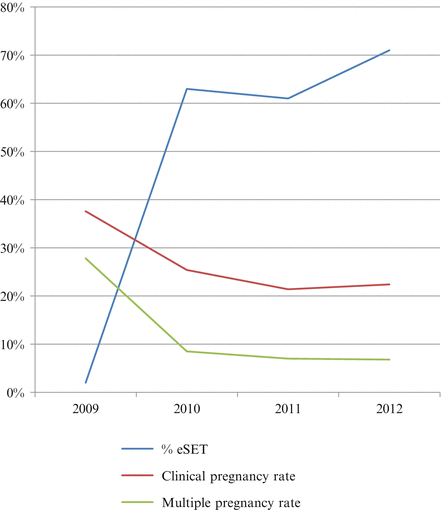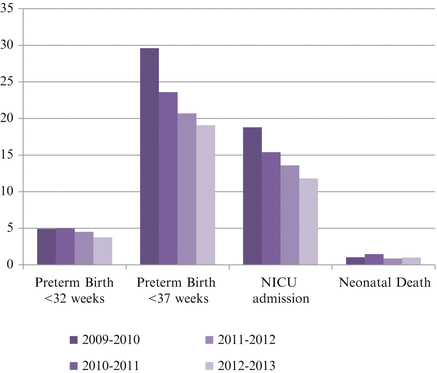Before funding (%)
After funding (%)
# eSETs
1.6
49
% clinical pregnancy per embryo transfer
42.7
31
Multiple pregnancy rate
27.2
5.2
As these data suggest, an increased proportion of elective single embryo transfer is clearly associated with a major decrease in the number of multiple pregnancies. However, this may be at the cost of a lower clinical pregnancy rate per embryo transfer. Nevertheless, there is some evidence that an equivalent clinical pregnancy rate per cycle is obtained after serial frozen/thawed eSET is performed [4, 5]. A study looking at cumulative pregnancy rates in a single center in Québec after the first year of implementation of the program reported pregnancy rates before coverage in patients of all ages after a fresh cycle to be the same as the cumulative pregnancy rate per cycle initiated after public coverage, without any statistically significant difference [4].
A randomized controlled trial was also recently published to study eSET vs. DET in good prognosis patients <38 years old. The results showed pregnancy rates similar after DET (46.9 %) and cumulative eSET (49.1 %). The live birthrates were also similar in the two groups: 42.2 % vs. 38.6 %, respectively. Interestingly, there were no multiple pregnancies in the eSET group, whereas the DET group had a multiple pregnancy rate of 27.6 % [5]. The higher pregnancy rate quoted in the second study is likely due to the fact that their study population was younger and had a good prognosis.
Over a longer term, it has been interesting to see if that effect of IVF public funding and mandatory eSET on treatment outcomes has been maintained. In 2013, the health ministry requested an analysis of the current situation by the Québec health and welfare commissioner. His report was published in 2014 [6] and offers a wealth of information on the program itself and its outcomes on population statistics. The data used in the analysis was mainly obtained from three sources: the Canadian ART Register of the CFAS, from billings of medical acts to the RAMQ, and lastly from the ministry-run MED-ECHO database, which collects statistics about hospitalization of patients. The numbers are extracted from MED-ECHO using mainly coding for admission diagnosis.
Proportions of eSET and Pregnancy Rates
First, looking at assisted reproduction techniques themselves, there has been a continued increase in the practice of eSET throughout the period of public coverage as well as a sustained decrease in multiple pregnancy rates. As demonstrated in Fig. 24.1, the rate of elective single embryo transfer dramatically increased after the implementation of public funding, from 1.6 % of all transfers to 49 % after 6 months, 62 % after 12 months, and 71 % of all transfers after 2 years. This change in practice remains the main explanation for the subsequent decrease in multiple gestations, from 27.8 % to 6.8 %. However, this success was at the cost of a decrease in the clinical pregnancy rates per single fresh cycle from 37.6 % to 22.4 % over the 3 years [6]. A clinical pregnancy was defined as intrauterine gestation (presence of a gestational sac on ultrasonography), ectopic pregnancy, or miscarriage diagnosed by histology. Cycles with only a positive pregnancy test (biochemical pregnancy) were not considered to have a clinical pregnancy [7].
Neonatal Outcomes
It is intriguing to explore whether this decrease in multiple pregnancy is translated into a clinically significant difference in neonatal outcomes. The hypothesis is that less multiple pregnancies should result in a diminution in premature births and consequently less neonatal intensive care admission. Data available from hospitalization of patients and admission codes was published in the commissioner’s report and is presented in Fig. 24.2. Overall, in the assisted reproduction population, the rate of preterm birth at less than 32 weeks and less than 37 weeks has diminished over the course of the program: from 4.9 % to 3.8 % and from 29.6 % to 19.1 %, respectively. Interestingly, NICU admissions were also decreased, from 18.8 % down to 11.8 % of all the births following assisted reproduction. However, average hospital stay was increased, especially for neonates born under 36 weeks of gestation. Neonatal death rate remained unchanged. Whereas the diminution in preterm birth and NICU admission is significant when analyzing the population of neonates born after ART, the effect is not seen when the whole population of newborns is taken into account. This is likely due to the fact that the ART-issued babies account for only 2 % of the newborn cohorts in Québec and therefore not in a proportion large enough to affect the overall population outcomes. The main limitation of this data however is the fact that it was obtained retrospectively, from charts review. Also the MED-ECHO databank is not linked with the RAMQ billing figures; hence, not all IVF cycles are necessarily accounted for.
Obstetrical Outcomes
It is well known that ART pregnancies and especially multiple gestations are associated with adverse obstetrical outcomes. Cesarean section rate, maternal hospitalization frequency, and stillbirth rate were analyzed in the commissioner’s report. Interestingly, cesarean delivery rate in the assisted reproduction patients increased, mainly in singleton pregnancies, from an initial rate of 28.0 % to 37.0 %. The reasons for this are unclear and may reflect increased numbers of patients with concomitant diseases now accessing treatment. For the multiple pregnancies, there was a decrease in the rate of cesarean birth from 74.4 % to 66.0 %. Maternal hospitalization rate also increased, from 32.2 % to 37.4 %. The main reason documented for maternal hospitalization was “increased surveillance for advance maternal age” (Fig. 24.3).






